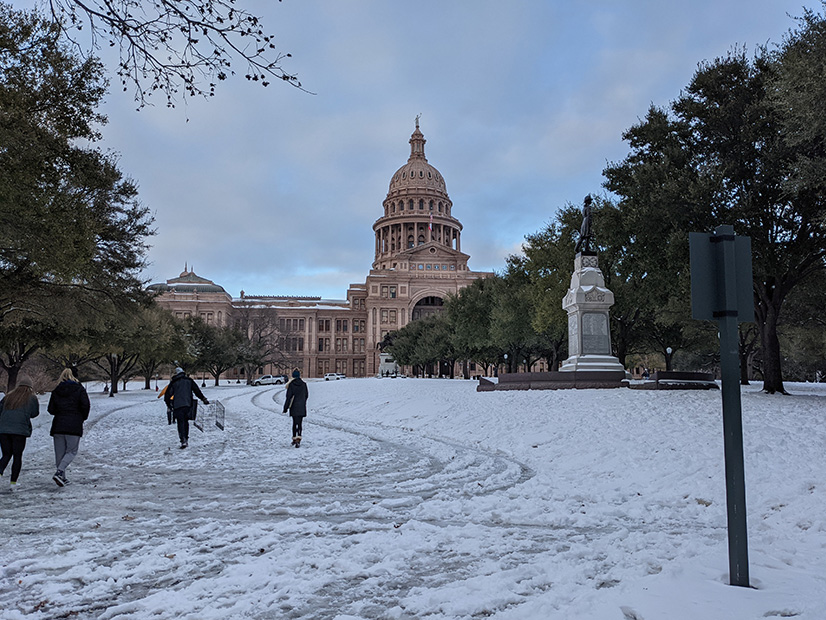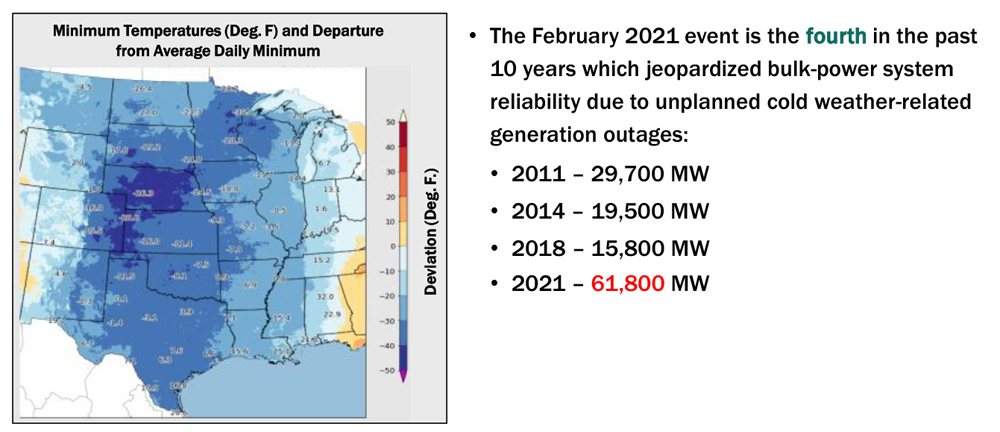
Snow covers a hill in front of the Texas Capitol.
| Jno Skinner, CC BY-4.0, via WikimediaFERC and NERC staff on Thursday presented a series of recommendations to prevent a recurrence of the February winter storm that led to unprecedented outages in the Midwest and left hundreds dead and caused billions of dollars in damages in Texas (AD21-18).
The joint inquiry team put much of the blame on a lack of gas supply that took more than 61 GW of power offline, calling for the electric and natural gas industries to strengthen their winter preparedness and coordination to prevent a recurrence.

Glick hearkened back to the 2011 winter weather event in Texas, which led to similar winterization recommendations.
“That recommendation was watered down to guidelines that few generators followed,” he said. “The biggest single reason [for the outages] was the vast majority of generators hadn’t winterized their facilities. I guarantee you that this time, FERC will not permit these recommendations to be ignored or watered down.”
NERC CEO Jim Robb joined Glick for a press conference after the meeting.
“I want to share [Glick’s] commitment … that this is not going to be a paper report that’s just going to sit on someone’s shelf and be valued because of the length of it and the weight of it,” he said. “We’re really going to be committed to putting this into action.”
Robb did throw a shoutout to ERCOT’s operators, who brought the grid back from the brink of collapse as they scrambled to meet record winter demand while dealing with a massive loss of generation. (See ERCOT: Grid was ‘Seconds and Minutes’ from Total Collapse.)
“I think it is impressive that the operator managed to not let the entire Texas grid collapse. That’s not much comfort to those without power for six or seven days, but I think there’s something to celebrate there,” he said.
ERCOT had to make do without an average of 34 GW of generation Feb. 15-17, according to the inquiry, equivalent to nearly half of its all-time winter peak of 69.9 GW before it began to lose generation.
The study team said the storm led to the largest controlled firm load-shed event in U.S. history and the third largest loss of load, trailing only the August 2003 Northeastern blackout and the August 1996 West Coast blackout. More than 1,000 generating units in the Midwest experienced either an outage, a derate or a failure to start from Feb. 8 to 20.
The team laid much of the outages’ blame on freezing generator components and fuel-supply issues. The report said all fuel types were affected but that 57% of the 1,045 impacted generators were natural gas-fired units that primarily faced fuel-supply challenges.

Referring to comments from Texas politicians and others who pointed fingers at renewable resources, Glick said, “Today’s report makes it clear that the facts don’t support this rhetoric. This should make us rethink the current approach to assess when dispatchable generation should be available.”
The preliminary report makes nine key recommendations, including changes to mandatory reliability standards that build upon those developed in the wake of a 2019 joint inquiry into a prior cold weather event and recently approved by FERC. (See FERC Approves Cold Weather Standards.)
The recommendations include:
- require generator owners to identify and protect cold weather-critical components;
- build new or retrofit existing units to operate to specific ambient temperatures and weather based on extreme temperature and weather data;
- take into account the effects of wind and precipitation in winterization plans;
- create corrective action plans for generator owners that experience freeze-related outages; and
- ensure the system operator is aware of the generating fleet’s operating limitations so that they can plan mitigation actions.
The preliminary report also recommends that generator owners be provided the opportunity for compensation and recovery of the costs of building or retrofitting to operate to a specific temperature, and that Congress, state legislatures and jurisdictional regulators require gas facilities to prepare and follow cold weather preparedness plans.
“We can’t allow this to happen again,” Glick said. “This time, we must take these recommendations seriously, and act decisively, to ensure the bulk power system doesn’t fail the next time extreme weather hits.”
Glick said the storm’s effects would have been much worse in SPP and MISO had they not been able to import power from PJM. He said ERCOT’s lack of interconnections with the other U.S. grids and its limited ability to import power was “unfortunate.”
“ERCOT is essentially an island unto itself,” Glick said, repeating a familiar expression among Texans who relish their freedom from FERC jurisdiction. “That is very short-sighted. That is nothing more than cutting off your nose to spite your face.”
The Texas Public Utility Commission is looking into strengthening its connections with the Eastern and Western Interconnections. ERCOT has also included an item to “assess the potential costs and benefits of increased transmission both internal and external to ERCOT and increase coordination with other power regions” in its 60-point roadmap to grid reliability.
“Changes are obviously needed to protect Texans from future winter weather events … and ERCOT is working closely with the PUC to aggressively implement [new state legislation],” ERCOT spokesperson Leslie Sopko said in an email. “We fully expect the report’s findings to complement the positive impact of the PUC’s market-redesign work sessions and our 60-point Roadmap to Improving Grid Reliability.”
Asked about ERCOT’s isolation and the PUC’s discussion of interconnections without involving FERC, Glick said he “couldn’t care less” about jurisdiction.
“All I care about is making sure that we don’t have a repeat of what happened last winter, which was tragic,” he responded, saying jurisdictional issues are for Congress to decide. “We just need to work with our friends at the PUC and other policymakers in Texas to encourage a greater level of interconnection. We can work out the concerns that they have about FERC jurisdiction; we can work that out down the road.”
The Texas Reliability Entity has scheduled a winter weatherization workshop Sept. 30 to review the cold weather standards and share best practices in preparing generators for severe winter weather.
“I appreciate the recommendations outlined within the report to improve grid reliability,” Texas RE CEO Jim Albright said in a statement. “We’ll continue to work with our stakeholders within the Texas Interconnection via outreach and training such as [the workshop].”
In an emailed statement, SPP spokesperson Meghan Sever said the RTO’s initial assessment of the preliminary findings and recommendations is in “strong alignment” with FERC’s.
“We’ve both determined that fuel-supply issues were at the heart of the reliability issues we experienced, that strong interconnections and effective communication helped to minimize the impacts of the storm, and that better coordination between the gas and electric industries is needed to mitigate the threats of similar events in the future,” she wrote. “We’re working hard to implement the recommendations that came from our own analysis and expect much of what we are working on to satisfy FERC and NERC’s recommendations.”
American Electric Power, a major player in the MISO and SPP markets, said it relies on the “collective reliability” of the combined fleet.
“Therefore, AEP supports the development of NERC standards that will assure that all generators in the regions are preparing for these conditions in a comparable fashion,” spokesman Scott Blake said in an email. “Similarly, we support efforts to improve the weatherization protection for the natural gas infrastructure, including having pipelines share the state of weatherization of their equipment with generators that may be adversely impacted.”
The inquiry team comprised nearly 50 staff members from FERC, NERC and its regional entities: Midwest Reliability Organization, Northeast Power Coordinating Council, ReliabilityFirst, SERC Reliability, Texas RE and WECC. The Department of Energy and the National Oceanic and Atmospheric Administration also contributed.
The final report is scheduled to be released before winter.



